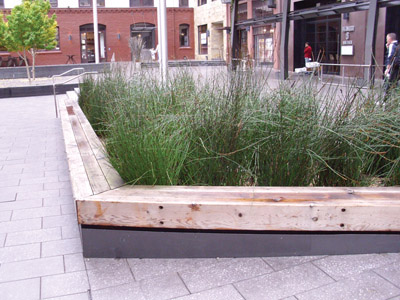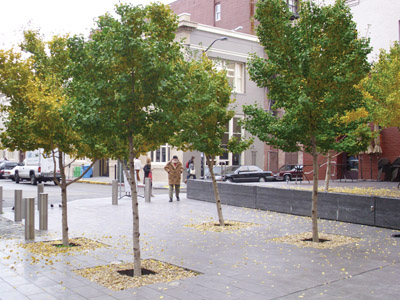Last month, San Francisco’s new-and-improved Mint Plaza was one of five projects selected to receive a 2010 National Award for Smart Growth Achievement from the U.S. Environmental Protection Agency.

For its 2010 National Award for Smart Growth Achievement, the United States Environmental Protection Agency created a new category, Civic Places, to recognize public spaces that incorporate sustainable design and best management practices. San Francisco Mint Plaza is the first to win in this new category. Photo by Bill Picture
Get with the program
Ensuring that the space was inviting to the public so that it didn’t once again fall into disuse was a key component of the design plan created by MBC and its partners, CMG Landscape Architecture and Sherwood Design. To that end, the layout was intentionally kept simple, sparse and open so that the space could be adapted for a variety of uses.
“A poorly planned or overly sanitized space has the opposite of its intended effect,” explained EPA Region 9 Administrator Jared Blumenfeld. “It doesn’t invite human interaction, and that’s critical to cities growing in a sustainable way.” Blumenfeld is intimately familiar with the Mint Plaza project because he served as director of the San Francisco Department of the Environment during the time that Mint Plaza was being overhauled.
“A lot of times what makes a space work or not work is hard to put your finger on,” he added. “I think what makes Mint Plaza work is that the designers approached it from a community-oriented perspective. They gave a lot of thought to what would make it inviting.”
Blumenfeld commended Friends of Mint Plaza for continuing in that community-oriented vein when it comes to programming events that make the space a destination for San Franciscans and their guests. During summer months, Mint Plaza plays host to a popular lunchtime music and dance series, as well as a weekly farmers market.
The owners of the historic buildings that flank Mint Plaza’s northern edge have filled their ground-floor commercial spaces with upscale cafes and restaurants—including Blue Bottle Café and Chez Papa Resto—that invite hanging out and contribute to the Plaza’s European flavor. Lilybelle Flower Cart, which offers organic and locally-sourced cut flowers, will soon be joined by other pushcart vendors offering a variety of local and sustainable goodies.
Even when there are no events and the crowds have died down, the space’s plantings, vine-entangled steel arbor and scattered seating invite passersby to pass some time in the Plaza with a book, a bag lunch or a friend.
“How well a space engages with its audience determines whether it lives or dies,” Blumenfeld adds. “You have to give people a reason to go there. Until now, people only had reasons not to go to this area. Now, when I take people there, there’s no trace of that. I think that speaks to the capacity of design to radically shift our perception of a space, and to the potential of cities to recreate themselves through the lens of sustainability.”
Understatedly green
Mint Plaza’s open and uncluttered layout not only makes it safer and more inviting for visitors, it also allows more natural light to penetrate the space, minimizing the need for electric lighting during daytime hours.
Because it’s not visible to the naked eye, however, few visitors know about the Plaza’s greenest element—its treatment of runoff storm water. Because wastewater (what goes down your drains) and storm water (what runs into the City’s gutters) share the same network of pipes in San Francisco, heavy rains can overtax the sewer system causing the overflow of untreated sewage into San Francisco Bay.
“Over the last thirty years, we’ve done an amazing job of reducing pollution and contamination,” says Blumenfeld. “Where we’ve failed, and that’s partly to do with the fact that there’s been little technological advance, is dealing with storm water runoff. And we need to stop diverting water into storm drains, which usually dump right into the ocean.”
Like most development projects, Mint Plaza’s plan called for the pouring of quite a bit of concrete. The more concrete, the more runoff that will likely be directed into nearby gutters. In Mint Plaza, however, shifted planes direct rainwater into planters and an underground infiltration system. By capturing the rainwater on-site, the City’s sewer system is spared any extra burden. The storm water treatment system is also very efficient and about as low-tech as it gets. It’s so easy to replicate that the San Francisco Public Utility Commission now uses it as a model for managing urban storm water.
“What I really love about Mint Plaza is that it doesn’t shout about being green the way so many other projects do,” says Blumenfeld. “Green is so woven into the fabric of the design that you can enjoy the space and not even know that it’s green. I’d say this is ‘green just doing its job.’”

To keep rainwater from running into nearby gutters, where it could overburden the City’s sewer system, Mint Plaza’s surface was designed to direct rainwater into on-site treatment gardens and an underground infiltration system. The low-tech storm water treatment system is being touted as an example of “low-impact development.” Photo by Bill Picture

The Plaza’s layout was intentionally kept open and uncluttered, with plantings strategically placed so as not to block sight lines or natural light, minimizing the need for electric lighting. In addition to making the space adaptable for a variety of uses and safer for visitors, the layout has also proven inviting for neighbors and nearby workers, who can regularly be found hanging out in the Plaza. Photo by Bill Picture

